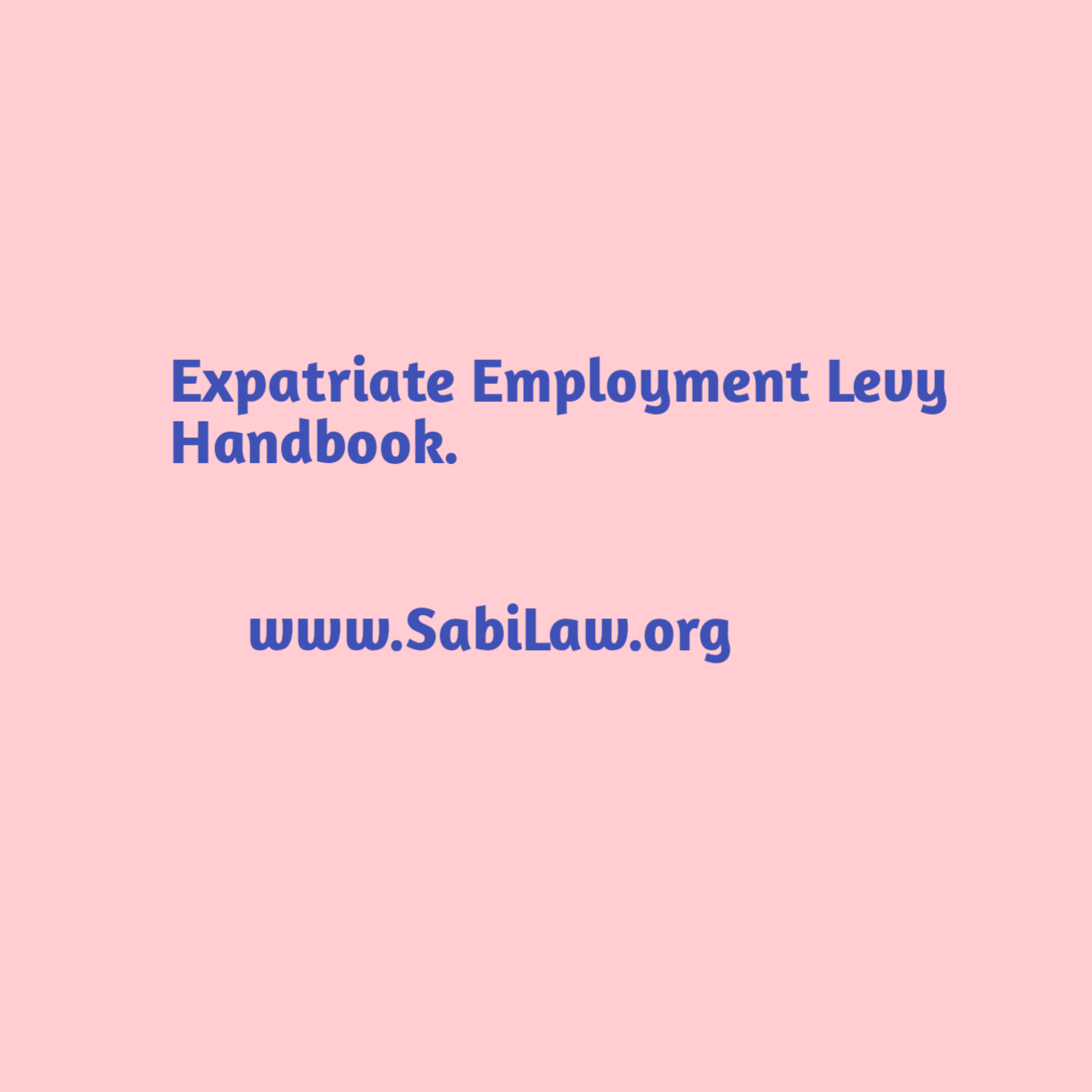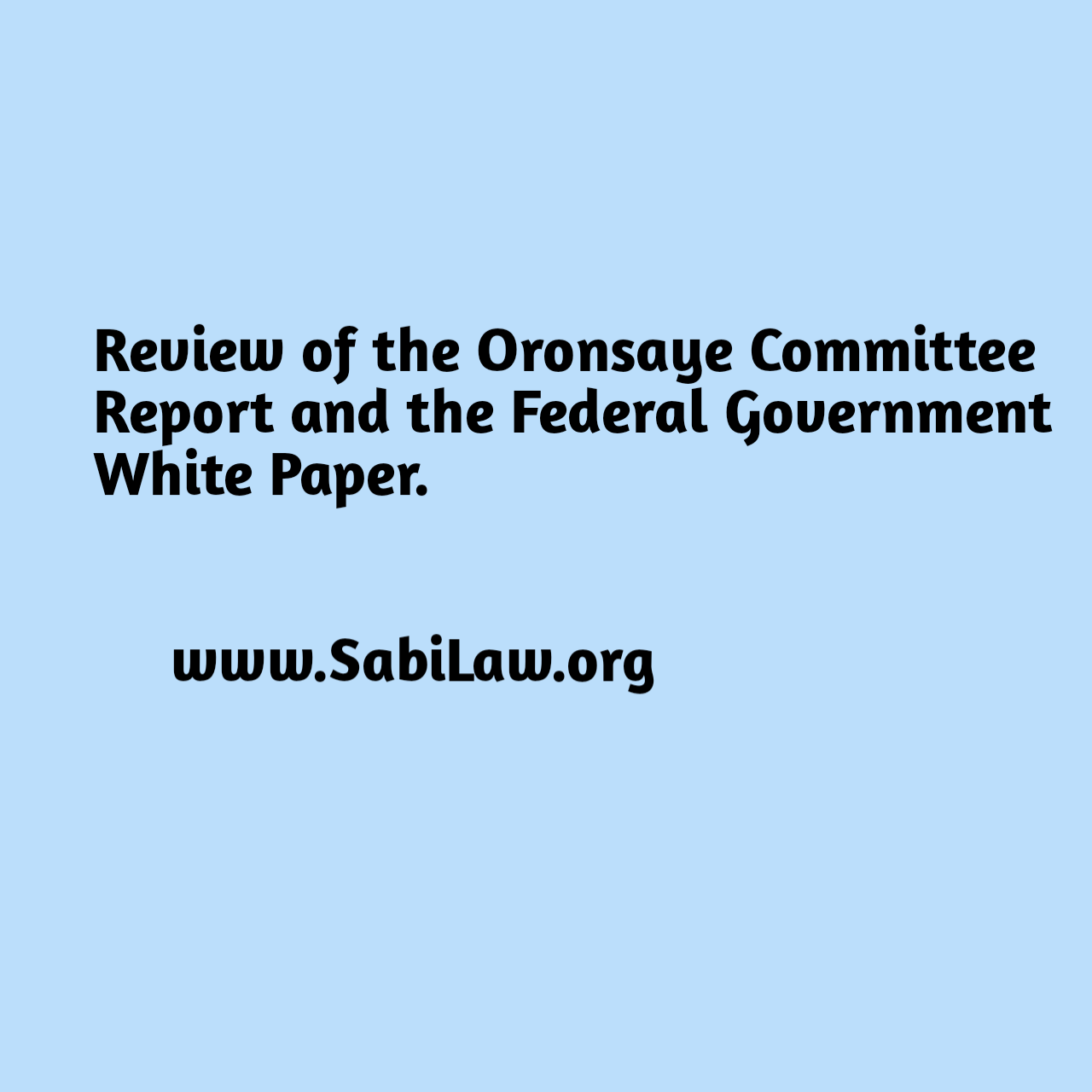Who Is An Employee At Common Law?
By FC Robinson
Abstract
The question of who is an employee at common law and its answer is very imperative to the study, interpretation, and application of employment law under Nigeria’s jurisprudence.
Not everyone who contracts to render services or to act on the orders of a master or an employer so to say is an employee under common law. More often than not, such a person may be an agent of the master or an independent contractor. However, because these persons invariably carry out the orders of the master and get some kind of remunerations as agreed in the contract, individuals, employers, employees, and even lawyers tend to imply that these relationships are the same. This is false because the duties and obligations between an employee and employer are not the same as that between a master and an agent, and a hirer and an independent contractor. In an action for breach of contract, the kind of relationship existing between the contracting parties is usually of importance as it determines if there was any breach and also remedies available. This work intends to clear the above misconception poised by the undue juxtaposition of an employee with an agent or an independent contractor by discussing the following;
- Who is an employee at common law?
- The test for determining who is an employee under common law.
- Who is an independent contractor?
- Similarities between an employer-employee relationship and a hirer-independent contractor relationship and;
- Differences between a hirer-independent contractor relationship and an employer-employee relation
I would conclude this essay by advising contracting parties to ensure that they understand the kind of contractual relationship they intend to go into and the duties, obligations, and interests that accrues to parties in such contractual relationships.
Introduction.
Employment may give rise to either a contract of service or a contract for service. While the former is between an employer and an employee or a master and a servant, the latter is between a hirer and an independent contractor. There is a need to decipher the differences or create a dichotomy between these relationships and to ensure the deciphered differences are highlighted, the reason for doing so are:
- Common law implies certain duties and rights in the relationship of employers and employees which are not necessarily applicable in these other relationships.
- The common law doctrine of vicarious liability is confined to the relation of employers and employees.
- The various labour law statutes do not generally apply to those who are not employees at common law.
From the above, it is lucid and glaring that the importance of creating a dichotomy between these relationships and making its differences understandable and clear too cannot be overstated.
Who Is An Employee At Common Law?
The above question and its answer are very imperative and pertinent in determining the kind of employment that exists between parties to an employment contract and as stated above the importance of answering this question cannot be overstated.
The answer to this question has over the years left individuals including lawyers and jurists in a conundrum. The courts in an attempt to clear this conundrum have enunciated some tests for determining who is an employee and some of these tests have been widely accepted and applied by other courts and jurists as well. These tests would be discussed subsequently.
Test For Determining Who Is An Employee At Common Law
As stated supra, the English/common law courts have over the years enunciated some acknowledged and accepted tests for determining who is an employee at common law, some of these tests includes;
- The control test.
- The multiple tests.
- The organisational test.
- The mixed or modern approach test.
We would proceed to discuss these tests.
The Control Test.
The control test is the basic and most important of all the tests postulated by the different courts. The control test was formulated by Bramwell LJ in Yewens v Noakes (1880) 6 QBD 530. The law lord stated thus “A servant is a person subject to the command of his Master as to the manner In which he shall do the Job”.
The amount of control a master has over a servant or an employer has over an employee is very pertinent in determining what kind of employment relationship exists between them. If the master instructs an employee or a servant on a duty to carry out and gives him further directives on how exactly he wants him to carry out the task, then such a person is an employee and is under a contract of service. However, if a hirer gives a duty to be carried out but doesn’t give further instructions on how he intends that such duty be carried out, such a relationship is that between a hirer and an independent contractor and is under a contract for service. The level and magnitude of control is the deciphering factor between a contract of service and a contract for service.
Furthermore, the relationship between an employee and employer can also be distinguished from that of a principal and agent using the control test. Whilst the employer has a right of control over his employee, the principal has no such right over his agent.
The control test is no longer applicable as skilled workers who are employees are told what to do and not how to do it. The court in Re Sunday Tribune corroborating the above premise expressed the following view “given the difficulties in relation to skilled workers who are told what to do but not how to do it, the control test was no longer of universal application and cannot be used definitely as in modern context, the nature of the employment contract may not be so simplistic”.
The Multiple Test.
The court in this test recognised that not just one factor can or would determine who is or who is not an employee. The court took cognisance and listed some factors that answer the question of who is an employee. One of the best-known statements was formulated by Mc Cardie J in Performing Right Society Ltd V Mitchell and Booker (Palais de Dense) Ltd.(1994)1 KB 762, he postulated thus “The nature of the task undertaken, the freedom of action given, the magnitude of the contract amount, the manner in which it is to be paid, the powers of dismissal and the circumstances under which payment the reward may be withheld, all these bear on the solution to the question, who is a servant”. Lord Thankerton restated similar indicia of the employer-employee relationship in a more concise form in Short v J and W Henderson Ltd (VLex) UKHL J0329-4, he stated thus “a) The masters’ power of selection of his servants; b) the payment of wages or other remuneration; and c) the master’s right to suspension and dismissal”. According to Mc Cardie J, the most important and final test, if there be a final test is the control test which he identified and stated as the “Freedom of action given”.
It seems a very important factor that determines whether or not a relationship is an employer-employee relationship is the employer’s power of hiring and dismissal. Another important factor noticed by both law lords is the payment of wages and salary to an employer, both of these factors have a serious bearing on whether or not a person is an employee. From both cases supra, some very important factors to be considered to determine whether or not an employment contract is that of service, some of these factors are:
- The master’s right to hire and dismiss an employee or a servant.
- The payment of wages or any other agreed remunerations.
- The nature and degree of detailed control over the person alleged to be a servant.
These factors seem to be the most imperative identifiable from the decisions of the court supra. The court in a subsequent case applied the Multiple test in determining the relationship between the parties. In Morren v Swinton & Pendlebury Borough council (1965) 1 WLR 756, the court held that the engineer appointed by the council, whose salary mileage, subsistence allowance, and national insurance contributions were all paid by the council. Above all, he was employed by the authority to work with the consulting engineers who were under a contract to carry out some work for the authority, was an employee, not an independent contractor or an agent.
The Organisational Test.
The organisational test is also known as the integration test. Here the courts consider whether the work being done is integral to the business operation of the person contracting for the service or whether the work done is just an accomplice to it. In the former scenario, the greater the work done is a part and parcel of the business operations of the hirer the more likely it is that the person who is hired is an employee. In the latter, when the duty performed by the person hired is just a mere accessory to the main operation, such a person is very like to be an independent contractor. This test was postulated and propounded by the revered Law lord, Denning LJ later MR in Stevenson, Jordan & Harrison Ltd v Macdonald & Evans, he said “under a contract for service, a man is employed as part of the business and then his work is done as an integral part of the business, whereas under a contract of service, his work although done for the business is not integrated into it”. The revered law lord, restated and reiterated the above in the subsequent case of Bank Voor Handel En Scheepvaart N.V. v Slatford & Anor (1953)-1-Q.B- 248, he observed thus “in this connection I would observe that the test of being a servant does not rest nowadays on submission to orders. It depends on whether the person is a part and parcel of the organisation”. The above decisions make lucid the organisational or integrational test and its application.
The Mixed Or Modern Approach Test.
This test is arguably the most modern and most widely accepted and applied test of all the tests formulated by the courts. The mixed test enunciated some conditions for determining what constitutes a contract of service and these conditions subjectively are abreast with modern and contemporary employment law practices.
This test was developed by McKenna J in Ready Mixed Concrete v Minister of Pensions and National insurance (1968) 2 QB 497. A contract between the plaintiff company and Thomas Latimer a driver stated that he was self-employed and an “independent contractor” and he paid all the lorry running costs. But he had to put the company’s colour on his truck. He also had to wear a uniform while he was working. He could only use the truck for Ready Mixed Concrete purposes. His remuneration was calculated on mileage and load. The question arose whether he was an “employee” or an independent contractor because the company was not paying his national insurance on his behalf. If he was self-employed they did not need to but if he was an employee then they needed to. McKenna J in deciding on the issue above held on to the facts, Latimer was not an employee but “a small businessman”. The most important part of the judgement is as follows:
“I must now consider what is meant by a contract of service.
A condition of service exists if these three conditions are fulfilled. (i) The servant agrees that in consideration of a wage or other remuneration he will provide his work and skill in the performance of some service for his master. (ii) He agrees impliedly or expressly that in performance of the service he would be subject to the other’s control to a sufficient degree to make the other master; (iii) the other provisions of the contract are consistent with it being a contract of service”.
I need to say a little about (i) and (ii).
As to (i). There must be a wage or other remuneration otherwise, there would be no consideration, and without consideration, they would be no contract of any kind. The servant must be obliged to his work or skill. Freedom to do a job either on one’s own or by another is inconsistent with a contract of service, though a limited or occasional delegation of power may not be.
As to (ii). Control includes the power of deciding the things to be done, how they shall be done, the means to be employed in doing it, and the time and place where it shall be done. All these aspects of control must be considered in deciding whether the right exists to a sufficient degree to make one party the master and the other the servant. The right need not be restricted.
From this decision of McKenna J, it’s glaring enough to see that this test has embedded in it all the requirements for determining the answer to the question of who is an employee. It is without any doubt in my mind that I opine, that the above test and postulation of McKenna is the most complete and feasible of all the tests in today’s modern world.
Who Is An Independent Contractor?
As pointed out earlier in this essay, an employment contract may give rise to two relationships which are: a contract of service and a contract for service. While the latter is between an employer or a master and a servant or an employee, the latter is between an independent contractor and a hirer.
An independent contractor has been defined by the Black’s Law Dictionary, 9th edition, 2009 page 839 as “one who is entrusted to undertake a specific project but who is left free to do the assigned work and choose the method for accomplishing it. It doesn’t matter whether the work done is for pay or gratuitously”.
An independent contractor carries out duties he contracted with the hirer to do but chooses how and when to do the said Job. Independent contractors are not subject to the orders their hirers but employees are.
Similarities Between An Employee And An Independent Contractor.
As pointed out earlier in this essay, the relationship between an employee and an employer and a hirer and an independent contractor has similarities and some of them are pointed out below.
- They are both binding contracts: In both relationships, there’s a contractual agreement binding them with their hirers or employers. While that between an employer and employee is called a contract of service, that between an independent contractor and a master or an employer, so to say is called a contract for service.
- There is an agreement to work or render service: In both relationships, there is usually an agreement to work or to render some services or apply some skill in exchange for agreed remunerations, without this they would be no contract at all because this represents the consideration. It is trite that consideration must be present for a contract to be valid and enforceable.
- In both relationships the hirers or employers of both the independent contractors and the employees, informs and or instruct them on what to do: Even though an independent contractor is not told how to do the job but he is told what to, and an employee is told what to do and how to do it. Refusal on the part of an employee to obey orders of his employer or master on how to do his job may be a ground for summary dismissal.
- Termination of contract: Like in every other contractual agreement, a contract of service and a contract for service, involving an employee and an independent contractor can be brought to an end. The above can either be by agreement, by performance or by a breach but just as every contract comes to an end one way or the other, both being a species of contract also comes to an end.
Differences Between An Employer-employee Relationship And a Hirer-independent Contractor Relationship.
We also pointed out earlier on in this essay, some differences exist between an employee’s relationship with the master, and between that of an independent contractor and his hirer some of the differences are highlighted below.
- Control of work style: Independent contractors are usually in control of the manner and the time at which their work should be done. Unlike an employee, who is told the time and manner in which he is to do the work. Refusal to do the work in such a manner may be termed wilful disobedience and as pointed out earlier may be a ground for summary dismissal or termination of the contract of service.
- Liability for Tort: An employer is generally vicariously liable for the negligence of the employee during the course of his duty. The hirer is also liable for the torts of the independent contractor more often than not. A hirer may be liable for the tort of an independent contractor in instances where he hires an incompetent person and as a result of his incompetence an innocent party is injured. Also, where an independent contractor acts negligently on the orders of a hirer, and a person is injured due to that such a hirer is liable for the tort of the independent contractor. Notwithstanding the above exceptions, a hiring party is more often than not, not liable for the negligence and torts of the independent contractor.
- Enjoyment of certain work benefits: Independent contractors are ineligible to enjoy employment benefits such as insurance, bonuses, and allowances to mention a few benefits while employees at common law are entitled to enjoy these benefits. For instance, the National insurance of Mr. Thomas Latimer was the reason for the dispute in Ready mixed concrete v Minister of National insurance and pensions cited supra, where the court held that Latimer was an independent contractor and thus his National insurance is not supposed to be paid by the plaintiffs.
- Provision of tools of the trade: Independent contractors provide tools and equipment used for carrying out the job contract, and in some instances a place to work. While, an employer must provide tools and instruments for the employee and also a safe place to work, failure to provide a safe place may make him liable for any injuries suffered by the employee. See the case of Latimer vs AEC Ltd (1958) AC 643.
- Payment of taxes: In most instances, independent contractors are responsible for the payment of their taxes, while employers generally pay the taxes of their employees.
- Duration of contract: Employees are most times employed for an indefinite period, while a contract with an independent contractor is usually for a fixed and definite period.
- Control of remuneration: Independent contractors usually have more control of their payment and the structure of their payments, more often than not they’re paid in lump sums for their job while an employee is usually paid agreed wages or salary usually offered by the employer. Employees have far lesser control over the payment of their salaries or wages compared to an independent contractor.
- Delegation of contract duties: An independent contractor can delegate his job or function to another contractor or person, while employees are required to do their jobs themselves. In some instances, a contract of service terminates at the death of the employee solely because the job must be done by the employees themselves and not even by their privy.
Conclusion.
Having defined and given an analysis of an employee and an independent contractor. I advise parties that intend to go into an employment contract to ensure that they are aware of the kind they intend to go into. It’s duties and implications and also interests and benefits that accrue to parties and also remedies for breach of such contract. The above would aid in avoiding individuals from entering into contracts different from what they intended.
About the Author
FC Robinson is a 300Level law student of Abia state university Uturu, Abia state.
You can contact the author via mail on redefineobinson970@gmail.com. Tel no. 07033380339.
****************************************************************************************
This work is published under the free legal awareness project of Sabi Law Foundation (www.SabiLaw.org) funded by the law firm of Bezaleel Chambers International (www.BezaleelChambers.com). The writer was not paid or charged any publishing fee. You too can support the legal awareness projects and programs of Sabi Law Foundation by donating to us. Donate here and get our unique appreciation certificate or memento.
DISCLAIMER:
This publication is not a piece of legal advice. The opinion expressed in this publication is that of the author(s) and not necessarily the opinion of our organisation, staff and partners.
PROJECTS:
🛒 Take short courses, get samples/precedents and learn your rights at www.SabiLaw.org
🎯 Publish your legal articles for FREE by sending to: eve@sabilaw.org
🎁 Receive our free Daily Law Tips & other publications via our website and social media accounts or join our free whatsapp group: Daily Law Tips Group 6
KEEP IN TOUCH:
Get updates on all the free legal awareness projects of Sabi Law (#SabiLaw) and its partners, via:
YouTube: SabiLaw
Twitter: @Sabi_Law
Facebook page: SabiLaw
Instagram: @SabiLaw.org_
WhatsApp Group: Free Daily Law Tips Group 6
Telegram Group: Free Daily Law Tips Group
Facebook group: SabiLaw
Email: lisa@sabilaw.org
Website: www.SabiLaw.org
ABOUT US & OUR PARTNERS:
This publication is the initiative of the Sabi Law Foundation (www.SabiLaw.org) funded by the law firm of Bezaleel Chambers International (www.BezaleelChambers.com). Sabi Law Foundation is a Not-For-Profit and Non-Governmental Legal Awareness Organization based in Nigeria. It is the first of its kind and has been promoting free legal awareness since 2010.
DONATION & SPONSORSHIP:
As a registered not-for-profit and non-governmental organisation, Sabi Law Foundation relies on donations and sponsorships to promote free legal awareness across Nigeria and the world. With a vast followership across the globe, your donations will assist us to increase legal awareness, improve access to justice, reduce common legal disputes and crimes in Nigeria. Make your donations to us here or contact us for sponsorship and partnership, via: lisa@SabiLaw.org or +234 903 913 1200.
**********************************************************************************





















































5 Responses
When I originally commented I appear to have clicked the -Notify me when new comments are added- checkbox and now whenever a comment is added I get 4 emails with the same comment. There has to be a way you can remove me from that service? Thank you!
Just a smiling visitor here to share the love (:, btw great design and style. “Treat the other man’s faith gently it is all he has to believe with.” by Athenus.
Fortunately, there is a new registrar cheap domain names from $0.99
Namecheap exists to help EVERYONE get, make, and achieve more online with less cost, hassle, and headaches. We offer everything you need to get online and thrive, from domains to hosting to security to specialist services and products — all with value built in.
Great prices, world-beating customer support, and extra resources come as standard. ==>> https://zeep.ly/rxViL
Fortunately, there is a new AI bot that can write the content fo website, and it’s fully optimized to increase your ranking as well.
You can see the magic of AI in a video here =>> https://zeep.ly/zePEY
Fortunately, there is a new AI bot that can write the content fo website, and it’s fully optimized to increase your ranking as well.
You can see the magic of AI in a video here =>> https://zeep.ly/zePEY